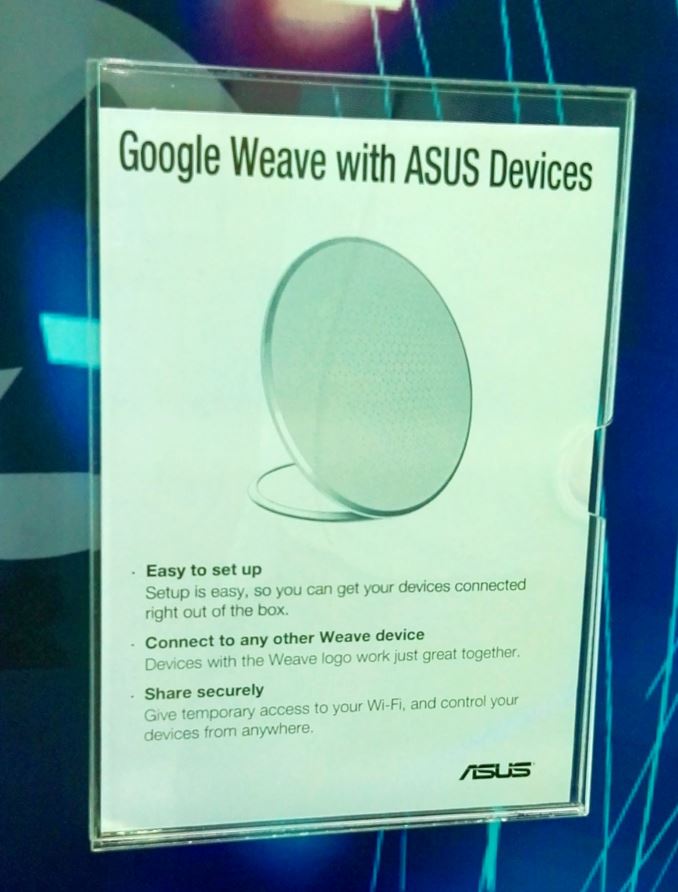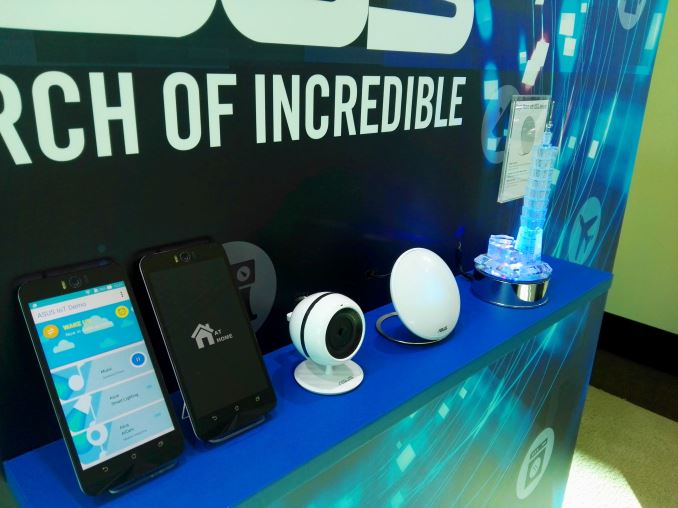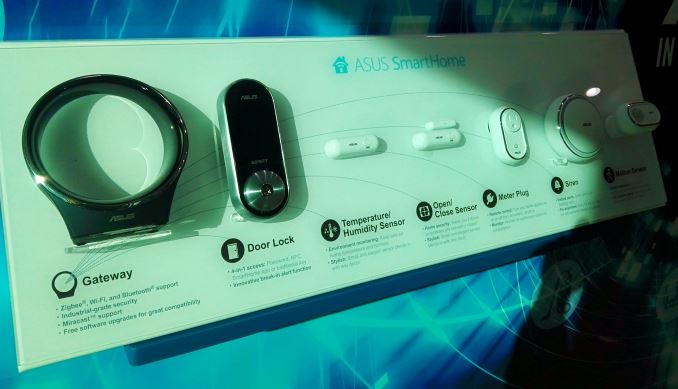ASUS Booth Tour at CES 2016: 10G Switches, External GPU Dock, USB-C Monitor and more
by Ian Cutress on January 19, 2016 9:00 AM ESTIn the last couple of years, every show we have attended affords the same questions on the Internet of Things: where do we see it going, when is it going to take off, what volume should be expect and what form factor will it arrive? You may have noticed that AnandTech has been relatively light on IoT coverage, perhaps for good reason: there’s an awful lot of awful hardware moving around at low cost, with most of it still in that beta stage of anything.
When the Internet of Things Becomes Useful
For me (Ian) personally, IoT has to satisfy two crucial categories: it has to be able to improve my daily flow of things, and it has to seamlessly work together. At the minute, most IoT fails to do either, especially with sportswear that merely tells you about what you have done. I don’t necessarily want to know what I have done (yes, I get the big data and improve angle), I want to be able to get things done quicker with the equipment at hand. Something as simple as being able to preopen a Chrome window at the webpage I need on my PC while I’m in the kitchen washing up so that it is there when I get to the computer. Or something that will tell me if the fridge/freezer door has been left open for more than five minutes again. Or a series of power monitoring outlets that I can access from a central application to see where my energy provider is clearly picking numbers out of thin air from. Or I can preload the next few music tracks/videos in my stream when I’m in another part of the house so that when I get there, it isn’t buffering the content or the advertisements for the first fifteen seconds. Does that sound like too much?
As we take baby steps into the future, ASUS is playing on the Google Weave project. Weave is designed to be the standardized API glue that binds products with Weave certification to be able to communicate with each other, the cloud, and the devices a user owns. As noted above, the design is meant for intra-comms within a network and internet communication over the web.
Over the next few years, as ASUS feels its way into the IoT space, I was told that Weave will be one of the standards they will keep close to, especially when it comes to hardware and software.
ASUS for the most part already offers a number of ‘SmartHome’ products, as shown above, and the assumption is that many of these down the line will fit into that Weave mold. My contention is that there are two very distinct levels of IoT product: ones that are designed to be binary (power switch is on/off), or ones that are designed to provide feedback (power switch that gives you a reading). It is the feedback devices that need to be configured so users can interpret the data. For example, if I have several power switches that can read power consumption, I want to be able to view how all of them are doing and perhaps record that data. If the software only allows me to connect with one at a time, or only view one at a time, that leaves it in the hands of the crowd that only wants binary operation. Ultimately I would argue it is the non-binary crowd who will be the early adopters. Same thing for smart locks, or temperature sensors – if I have several smart locks around the house, I want to know the status of each one, and perhaps I want push notifications when one is used (or abused).
I always say a lot of IoT devices have potential, the issue for me is always going to be utility, configuration, ease of use and software. Though the obvious prediction for now is that there will be several standards that won’t interoperate and a user will have to invest into a certain ecosystem to get the best benefit. That kind of sounds like the smartphone Android vs iOS debate all over again. Fingers crossed it runs a bit smoother for IoT.













50 Comments
View All Comments
DanNeely - Tuesday, January 19, 2016 - link
Is the back of that phone actually made up of a bunch of triangular panels at angles to each other; or does the finish just fake the look?WorldWithoutMadness - Tuesday, January 19, 2016 - link
It is 3D (source http://www.androidcentral.com/hands-asus-zenfone-2...Panzerknacker - Tuesday, January 19, 2016 - link
I just dont understand why did 10G never become mainstream and is it so damn expensive? Back when 100mbit was mainstream the price of 1G was higher but nowhere near $760 for a switch. 1g is now mainstream for a decade or so, what takes it so long? Did we reach the limit of copper networking? I mean, in datacenters there has to be a enormous market for fast networking, I cannot understand why prices are still so high because on a huge market you would expect a lot a competition and fast development of hardware. Or did they completely move to different networking standards in datacenters, like fibre?Reflex - Tuesday, January 19, 2016 - link
Power consumption is very high compared to gigabit, and wireless replaced ethernet for most home and small office use, thus negating economies of scale which normally would drive prices down.Lieuchikaka - Thursday, June 2, 2016 - link
http://mavangvn.vn/ma-vang-dien-thoai/dien-thoai-s...TwistedKestrel - Tuesday, January 19, 2016 - link
It's mostly the ubiquity of 1GbE vs the handful of vendors making 10GbE parts. 1GbE PHYs are cheap as dirt, and 10GbE is two orders of magnitude more expensive... and there aren't that many people that want it yet. Once 1Gb+ throughput on 802.11ac radios becomes more commonplace instead of mostly theoretical, that would be something of a driver for consumer 10GbE.Interesting that a few US ISPs have upcoming or available service in excess of 1Gb, I wonder what kind of connections their equipment would have
DanNeely - Tuesday, January 19, 2016 - link
For consumer service, I'd be really surprised if it was anything but a combined modem/pretend it actually is able to achieve multi-gigabit speeds wifi router.iwod - Tuesday, January 19, 2016 - link
They have new standard NBase-T which provides 2.5Gbps and 5Gbps on Normal CAT 6 Cable. But no idea why no company are getting products out.Alex_M - Wednesday, January 20, 2016 - link
The real benefits for NBase-T will be 2.5/5 Gbps over exisitng Cat5e (not Cat6) upto 100m. It means we don't have to replace all those existing cable runs to benefit from the higher speed. Its fairly new but I hear that the silicon has started sampling....Lieuchikaka - Thursday, June 2, 2016 - link
http://mavangvn.vn/ma-vang-dien-thoai/dien-thoai-s...